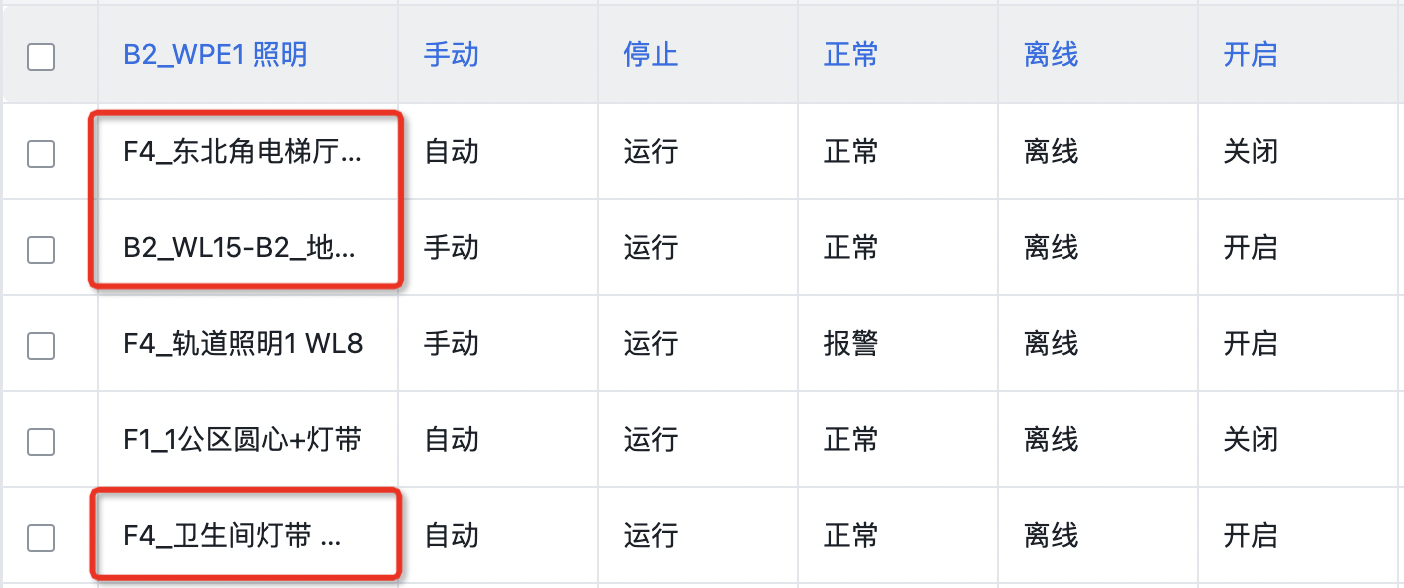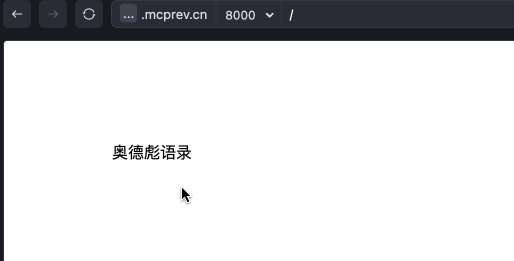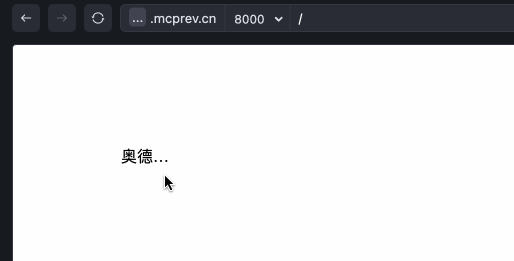大家好,欢迎来到IT知识分享网。
原生title属性的弊端
日常开发中,我们经常会遇到hover文本,显示其全部内容的需求。但是原生的title属性有两个很大的缺点
- 样式丑陋,无法更改
windows下的样式
mac下的样式
- 不够智能,属性显影只能人为控制
只要写了title属性,hover文本一定会展示。但有些场景,我们需要的功能是,文本超出后,才显示title属性;文本不超出后,不显示title属性。
如图,我们期望的是,被圈起来的部分,hover文本后出现title属性的提示;为圈起来的文字不需要title提示。
但是,title属性很那用,一旦你写了,它永远都会hover显示。
那么,针对上述问题,本文将对title属性进行优化,模拟实现一个更好用的title属性,它具备下面的功能。
- 样式好看(支持自定义):
- 仅超出的文本显示title提示:
相信阁下使用后,一定会让你们的同事领导对你刮目相看,想起他们故乡的妈妈桑!
为什么不使用第三方组件
有人一定会问,为什么不使用elementPlus的toolTip组件
我的回答是:
- 项目中没有或不能引入其他UI库
- 它的样式不满足我的需求
- 我想实现一些个性化功能
如果还有人和我杠,我就一句话: 我就想手搓一个,我乐意!
实现思路
首先,我们要明确的是,重写原生标签的 title 属性样式在纯 HTML 和 CSS 中是不可能的。不过,我们需要使用自定义的提示框(tooltip)来实现类似的效果,并对其样式进行完全控制。
大致思路就是:获取文本的鼠标hover位置,全局创建一个div盒子,用fixed布局浮动显示。
本文只抛砖引玉,做基础的代码演示,方便各位读者阅读。大家可以根据业务情况自行完善。
为了提升大家的学习效果,大家可以使用云VCSODE运行下面的demo代码。
云vscode参考地址:https://juejin.cn/post/0(文末链接)
云vscode免配任何环境,可快速运行demo。
技术方案
我们对下面的代码模拟hover实现title属性,hover提示:只要肯吃苦,吃得苦中苦,就有吃不完的苦
原生html
<div class="title"> 奥德彪语录 </div> 我们的大致方案是,hover时(mouseenter),获取当前dom元素,计算出它的位置。然后创建一个全局div,自定义一些样式,写入文本。鼠标 离开时,销毁当前元素。
基础框架
大致的逻辑框架代码如下:
<!DOCTYPE html>
<html lang="en">
<head>
<meta charset="UTF-8">
<meta name="viewport" content="width=device-width, initial-scale=1.0">
<title>Custom Tooltip</title>
<link rel="stylesheet" href="styles.css">
</head>
<body>
<div class="title" οnmοuseenter="createTip">奥德彪语录</div>
</body>
<script>
const titleDom = document.querySelector('.title');
let tipDiv= null
titleDom.addEventListener('mouseenter', ()=>{
// 创建一个tip提示div
tipDiv = document.createElement('div');
})
titleDom.addEventListener('mouseleave', ()=>{
// 销毁tip提示div
})
</script>
</html>
完善mouseenter方法
const titleDom = document.querySelector('.title'); let tipDiv= null titleDom.addEventListener('mouseenter', ()=>{
// 创建一个tip提示div tipDiv = document.createElement('div'); tipDiv.className = 'custom-tooltip'; tipDiv.innerText = '只要肯吃苦,吃得苦中苦,就有吃不完的苦'; document.body.appendChild(tipDiv); // 计算tip提示框的位置 // 获取 titleDom 元素的边界矩形信息 const rect = titleDom.getBoundingClientRect(); // 获取 tipDiv 元素的边界矩形信息 const tipRect = tipDiv.getBoundingClientRect(); tipDiv.style.left = rect.left +'px'; tipDiv.style.top = `${
rect.top - tipRect.height -10}px`; }) 我们完善一下custom-tooltip的样式
<style> .title{
margin: 100px; } .custom-tooltip{
position: fixed; padding: 8px 12px; background: rgba(27, 33, 41, .8); color: #ffffff; border-radius: 5px; border: 1px solid rgba(27, 33, 41 .8); z-index: 99; } </style> 试试效果,看起来还不错。
完善mouseleave方法
现在,我们实现离开dom,移除tip提示的效果。
titleDom.addEventListener('mouseleave', ()=>{
// 销毁tip提示div tipDiv.remove(); }) 完善文本超出才显示tip效果
要想实现这个效果,首先我们需要判断文本是否超出显示。如果超出,hover显示tips提示,否则不显示。
先改造样式,让文本超出显示…
.title{ margin: 100px; width: 50px; overflow: hidden; text-overflow: ellipsis; white-space: nowrap; } 现在hover,文本一定是一直显示的。
判断文本是否超出其容器,可以通过比较文本内容的实际尺寸和容器的尺寸来实现。
const titleDom = document.querySelector('.title'); if (titleDom.scrollWidth > titleDom.clientWidth) {
console.log('文本超出'); } else {
console.log('文本没有超出'); } 那么,代码的修改就非常容易了
titleDom.addEventListener('mouseenter', ()=>{
if (titleDom.scrollWidth <= titleDom.clientWidth) {
return } // ...原来的逻辑 }) titleDom.addEventListener('mouseleave', ()=>{
// 销毁tip提示div 兼容写法 tipDiv?.remove?.(); }) 完整代码
<!DOCTYPE html> <html lang="en"> <head> <meta charset="UTF-8"> <meta name="viewport" content="width=device-width, initial-scale=1.0"> <title>Custom Tooltip</title> <link rel="stylesheet" href="styles.css"> <style> .title{
margin: 100px; width: 50px; overflow: hidden; text-overflow: ellipsis; white-space: nowrap; } .custom-tooltip{
position: fixed; padding: 8px 12px; background: rgba(27, 33, 41, .8); color: #ffffff; border-radius: 5px; border: 1px solid rgba(27, 33, 41 .8); z-index: 99; } </style> </head> <body> <div class="title">奥德彪语录</div> </body> <script> const titleDom = document.querySelector('.title'); let tipDiv= null titleDom.addEventListener('mouseenter', ()=>{
if (titleDom.scrollWidth <= titleDom.clientWidth) {
return } // 创建一个tip提示div tipDiv = document.createElement('div'); tipDiv.className = 'custom-tooltip'; tipDiv.innerText = '只要肯吃苦,吃得苦中苦,就有吃不完的苦'; document.body.appendChild(tipDiv); // 计算tip提示框的位置 // 获取 titleDom 元素的边界矩形信息 const rect = titleDom.getBoundingClientRect(); // 获取 tipDiv 元素的边界矩形信息 const tipRect = tipDiv.getBoundingClientRect(); tipDiv.style.left = rect.left +'px'; tipDiv.style.top = `${
rect.top - tipRect.height -10}px`; }) titleDom.addEventListener('mouseleave', ()=>{
// 销毁tip提示div tipDiv?.remove?.(); }) </script> </html> 封装成一个方法
<!DOCTYPE html> <html lang="en"> <head> <meta charset="UTF-8"> <meta name="viewport" content="width=device-width, initial-scale=1.0"> <title>Tooltip Component</title> <link rel="stylesheet" href="styles.css"> </head> <body> <script> class Tooltip {
constructor(titleDom, text) {
this.titleDom = titleDom; this.text = text; this.tipDiv = null; this.titleDom.addEventListener('mouseenter', () => {
this.show(); }); this.titleDom.addEventListener('mouseleave', () => {
this.hide(); }); } show() {
if (this.titleDom.scrollWidth <= this.titleDom.clientWidth) {
return; } this.tipDiv = document.createElement('div'); this.tipDiv.className = 'custom-tooltip'; this.tipDiv.innerText = this.text; document.body.appendChild(this.tipDiv); const rect = this.titleDom.getBoundingClientRect(); const tipRect = this.tipDiv.getBoundingClientRect(); this.tipDiv.style.left = `${
rect.left}px`; this.tipDiv.style.top = `${
rect.top - tipRect.height - 10}px`; } hide() {
if (this.tipDiv) {
this.tipDiv.remove(); } } } const titleDom = document.querySelector('.title'); const tooltip = new Tooltip(titleDom, '只要肯吃苦,吃得苦中苦,就有吃不完的苦'); </script> </body> </html> 优化项
对于这个demo其实还有很多优化项,比如
- 如何让控制tip的位置居中
- 主题设置(黑白主题)
由于原生html用的很少,这里只简单展示一些技术思路,其他效果大家自行实现。
vue框架中实现
封装成一个组件
在vue中实现就简单很多了,比如,我们可以像下面一样简单粗暴,直接控制tooltip文本的显示隐藏即可。
<template> <div class="title-wrapper" @mouseenter="showTooltip" @mouseleave="hideTooltip"> <div class="title">{
{
title}}</div> <span v-if="showTooltipFlag" class="tooltip">{
{
tooltipText}}</span> </div> </template> <script setup> import {
ref } from 'vue'; const props = defineProps({
title: String, tooltipText: String }); const showTooltipFlag = ref(false); function showTooltip() {
if (this.titleDom.scrollWidth <= this.titleDom.clientWidth) {
return; } showTooltipFlag.value = true; } function hideTooltip() {
showTooltipFlag.value = false; } </script> <style scoped> .title-wrapper{
width: 50px; overflow: hidden; text-overflow: ellipsis; white-space: nowrap; cursor: pointer; position: relative; } .title{
margin: 100px; } .tooltip{
position: absolute; padding: 8px 12px; background: rgba(27, 33, 41,.8); color: #ffffff; border-radius: 5px; border: 1px solid rgba(27, 33, 41.8); z-index: 99; white-space: normal; top: -30px; left: 0; width: 200px; pointer-events: none; } </style> 如果你觉得这种组件的形式不够优雅,我们可以直接封装成一个vue指令。
封装成一个指令
定义自定义指令
在 v-tooltip.js 中定义自定义指令,并将样式动态添加到页面。
// src/directives/v-tooltip.js const tooltipStyles = ` .custom-tooltip { position: fixed; padding: 8px 12px; background: rgba(27, 33, 41, 0.8); color: #ffffff; border-radius: 5px; border: 1px solid rgba(27, 33, 41, 0.8); z-index: 99; } `; function addTooltipStyles() {
const styleElement = document.createElement('style'); styleElement.innerHTML = tooltipStyles; document.head.appendChild(styleElement); } export default {
mounted(el, binding) {
addTooltipStyles(); let tipDiv = null; const showTooltip = () => {
if (el.scrollWidth <= el.clientWidth) {
return; } tipDiv = document.createElement('div'); tipDiv.className = 'custom-tooltip'; tipDiv.innerText = binding.value || '只要肯吃苦,吃得苦中苦,就有吃不完的苦'; document.body.appendChild(tipDiv); const rect = el.getBoundingClientRect(); const tipRect = tipDiv.getBoundingClientRect(); tipDiv.style.left = `${
rect.left}px`; tipDiv.style.top = `${
rect.top - tipRect.height - 10}px`; }; const hideTooltip = () => {
if (tipDiv) {
tipDiv.remove(); tipDiv = null; } }; el.addEventListener('mouseenter', showTooltip); el.addEventListener('mouseleave', hideTooltip); el.__showTooltip__ = showTooltip; el.__hideTooltip__ = hideTooltip; }, unmounted(el) {
el.removeEventListener('mouseenter', el.__showTooltip__); el.removeEventListener('mouseleave', el.__hideTooltip__); } }; 注册指令
在 main.js 中注册这个自定义指令。
// src/main.js import { createApp } from 'vue'; import App from './App.vue'; import vTooltip from './directives/v-tooltip'; const app = createApp(App); app.directive('tooltip', vTooltip); app.mount('#app'); 使用指令
在你的组件中使用这个自定义指令。
<!-- src/components/TooltipExample.vue --> <template> <div class="title" v-tooltip="'只要肯吃苦,吃得苦中苦,就有吃不完的苦'"> 奥德彪语录 </div> </template> <style scoped> .title { margin: 100px; width: 50px; overflow: hidden; text-overflow: ellipsis; white-space: nowrap; } </style> 总结
本文介绍了原生title属性的一些优化思路和方法,相信对大家有一定帮助。由于时间问题,本文没有做组件或指令的深度封装,比如提示框出现的位置等等还不支持个性化自定义位置等等。但是,基于demo,已经达到项目可用的地步了,大家可以基于自己的项目自行完善。
如果你很懒,想让我帮你实现更多具体功能,请评论区留言,我会抽空完善上述代码,增加更过功能。如果有人想要react版本的,请留言,我根据评论情况添加。
关注我!前端不迷路!
免责声明:本站所有文章内容,图片,视频等均是来源于用户投稿和互联网及文摘转载整编而成,不代表本站观点,不承担相关法律责任。其著作权各归其原作者或其出版社所有。如发现本站有涉嫌抄袭侵权/违法违规的内容,侵犯到您的权益,请在线联系站长,一经查实,本站将立刻删除。 本文来自网络,若有侵权,请联系删除,如若转载,请注明出处:https://haidsoft.com/152352.html










